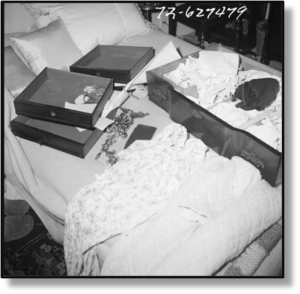
RESOLUTE JUSTICE
is a True Crime nonfiction book about the formation of the LA Cold Case unit and their most interesting solved cases through the eyes of 3 homicide detectives and a major crimes prosecutor.
81,572 words. Photographs.
SYNOPSIS

with Candelabra Murder Weapon on Bed
(Courtesy of LAPD Crime Scene Technician)
After DNA technology emerged, the Los Angeles Police Department had thousands of unsolved murders with DNA evidence stored away. Who was going to rework these cases with the new technology? The LAPD formed the Cold Case unit in 2001 to breathe new life into these old cases.
Unexpectedly, the cold case unit discovered many serial killers. But they did not know the identity of the suspects who left behind their DNA. Whom did it belong to? Detective Richard Bengtson was the first who solved his landmark case using surreptitiously collected DNA to prove a match to a murderer. How did he deal with the legal challenge of the 4th amendment regarding illegal search and seizure? He couldn’t just walk up to a suspect and say, “Hey, let me take a sample your DNA without a warrant.”
When detective Bengtson looked for victims of the Westside Strangler, he examined cases with the same MO. These were crimes of elderly white women killed by a rapist that came in through the balcony. Helen Meyler fit that description in her 1972 rape/murder. But instead of finding DNA matched for the Westside Strangler, Bengtson made the surprise discovery that the killer’s DNA matched the serial criminal, known as “The Balcony Burglar” who was caught in Santa Monica in the 1980’s.
Meyler’s killer went to trial in 2016, just before he would have been released for his other crimes. His colorful antics include pretending to be mute, attacking a court-ordered psychiatrist, refusing to leave his jail cell, and firing and rehiring his public defenders.
We follow several of District Attorney Beth Silverman’s most intense capital cases and see why she is considered “The best of the best” major crimes prosecutor.
DNA science and the fascinating history of DNA evidence leads us to the groundbreaking moment when a judge first ruled that DNA was accepted technology, and the first conviction using DNA.
PLATFORM
There are no books regarding the formation of the cold case unit, and summarizing the major cases through the eyes of the detectives who solved them. A similar book would be The Onion Field by Joseph Wambaugh.
I am well connected to the law enforcement community in Los Angeles (physical exams, work related injuries), and New York (World Trade Center toxicologist who does yearly monitoring of first responders)
The manuscript was read for accuracy by the detectives themselves, Rick Jackson, Richard Bengtson, Lee Kingsford, and capital prosecutor Beth Silverman.
ACKNOWLEDGEMENT
My wife asked me what surprised me the most about writing this book.
My answer is, quite simply, I did not realize how much those who work in the criminal justice system are affected in their personal lives by what they do. Detectives and prosecutors are subjected to a high degree of risk and threat of harm in each case they are involved in, which makes it necessary for them to carry weapons and work in fortified buildings. Often they must sequester their families in distant communities to keep them safe. As they work through their cases collecting evidence and finding the “bad guys,” they talk to the grieving families and spend time with them. They get to know them. In fact, they become so deeply immersed in their victims’ families’ lives, they feel the sense of loss as their own. If the case goes unsolved, often they carry that loss for years as they continue to search for new leads, new evidence that will help bring closure to the families who are suffering. And yet they go on, bearing the tremendous emotional toll, and continuing to do their jobs.
I expected to be objectively detached as I wrote this book, but at times, I cried for the victims and their loved ones. Also, the image I had of the people working in the criminal justice system also changed. I had thought the work of detectives was simple and dull, but now I understand the intelligence, perseverance, and emotional strength it takes to keep the moving pieces together; to gather evidence from clues, identify a suspect, and see a case through trial. And despite being overworked, I found that public defenders and district attorneys are unbelievably dedicated and proud of their accomplishments in the judicial system. They seek justice for all, and a “win” means one less threat to society. In order to sustain the highest degree of ethics, they undergo rigorous and continuous training, and all the while their every action is scrutinized by judges, the families of both the victims and the criminals, and the press.
For these diligent, sacrificing, hard-working men and women who strive daily to make our lives safer and our homes a better place to live, the least I can do is tell their story.
